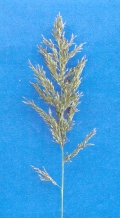
Consol lovegrass

Consol lovegrass
(High-resolution
image available)
| Pasture type and use | A long-lasting perennial spring/summer/autumn growing grass. Useful for grazing, hay and silage for mainly dryland use on acidic light sandy to sandy loam, and loam soils. Useful for control of spiny burr grass and some other summer-growing weeds (e.g. blue heliotrope). |
|---|---|
| Area of adaptation | North West Slopes and Plains, Central West Slopes and Plains. Not for local government areas where African lovegrass (Eragrostis curvula) is a declared noxious weed. |
| Min. average annual rainfall | 350 mm (southern NSW) to 400 mm (northern NSW). |
| Advantages |
|
| Disadvantages |
|
| Soil requirements | Acid sandy soils to medium loams. Will grow in pH(Ca) 4.0–6.0. Suits well-drained soils and those with reasonable depth (but can grow successfully on soils only 40 cm deep). Can tolerate exchangeable soil aluminium greater than or equal to 30%. |
| Varieties | Consol |
| Sowing rates: |
|
| Sowing time | Spring / early summer is a common time to sow (spring is preferred for southern NSW). Dry sowing may be necessary depending on follow-up rain for establishment. In northern areas, good success has been achieved from autumn/winter sowings. However, once conditions become cool, germination won’t occur until soils warm in the following spring/summer. |
| Companion species | Premier digit grass; Rhodes grass (in less extreme acid lighter soils). Where paddock soil type is variable, it is often sown with lucerne. It is essential to grow with legumes (e.g. serradella) on very acid soils. Annual legumes are generally easier to establish and can be added at a later stage when consol is sown in spring. |
| Inoculation | N/A |
| Major nutrient deficiencies | Nitrogen, phosphorus, sulfur and occasionally potassium. |
| Main insect pests | Generally no major pest problems. |
| Main diseases | Generally no major disease problems. |
| Management | Do not graze new stands until plants are adequately anchored. For best livestock performance, avoid rank growth. The most nutritious stage is young to medium regrowth.
It is important to allow plants to periodically seed down if initial stands are thin. Periodically rest to replenish root reserves. Consol can tolerate set stocking over short periods; however, continuous grazing (depending on stocking rate) can increase erosion risk and reduce potential livestock production. |
| Livestock disorders of particular note | No problems reported. |
| Additional tips |
|
Acknowledgments
The contribution of Bill Johnston, from the Department of Infrastructure, Planning and Natural Resources, Wagga Wagga, is gratefully acknowledged.
Advice on livestock health disorders was provided by Dr Chris Bourke, Principal Research Scientist, NSW Agriculture, Orange. His contribution is gratefully acknowledged.
Photo: Bill Johnston, DIPNR, Wagga Wagga.

